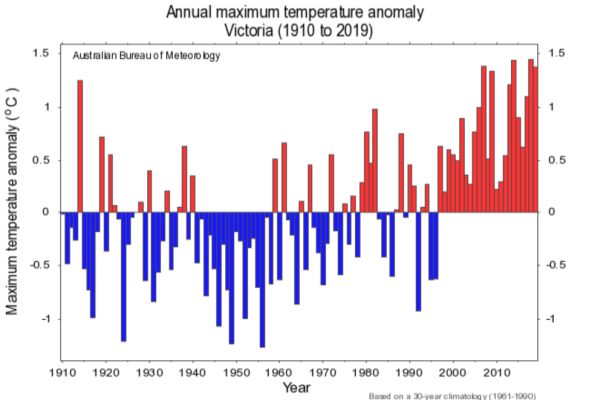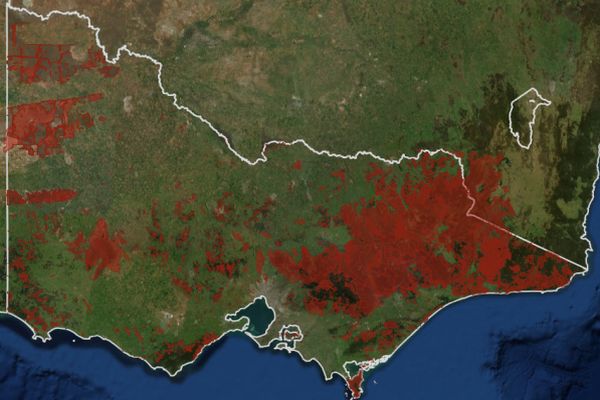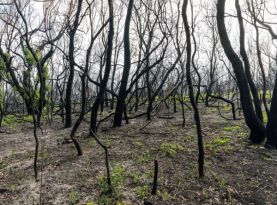January 2020 Eastern Victoria Bushfires & Biodiversity
This page is set up to share information about biodiversity; potential impacts and recovery related to flora and fauna, including collating a list of post fire research projects in areas which have been impacted upon by the January 2020 bushfires in North East & Gippsland, Victoria.
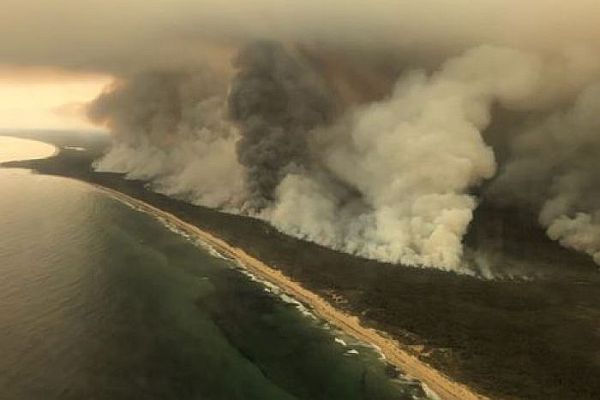
One of the fires burning in the East Gippsland Lowlands bioregion 4 January 2020. Image courtesy of Australian Maritime Safety Authority
How you can help
There are many opportunities to contribute to the bushfire recovery efforts through data for wildlife projects, environmental volunteering or looking after your private land.
Bushfire Recovery - community wildlife reporting
Members across the community are asked to report sightings of six key species within fire-affected (and neighbouring) areas;
- Glossy Black Cockatoo / Calyptorhynchus lathami
- Eastern Ground Parrot /Pezoporus wallicus
- Diamond Python / Morelia spilota
- Spot-tailed Quoll / Dasyurus maculatus
- Lace Monitor / Tree Goanna /Varanus varius
- Koala / Phascolarctos cinereus
iNaturalist: Environment Recovery Project - Australian Bushfires
Contribute your images to help researchers understand how species recover from the 2019-2020 bushfire season.
https://inaturalist.ala.org.au/projects/environment-recovery-project-australian-bushfires-2019-2020
NatureWatch - Life After Fire
This project brings citizen science wildlife monitoring to four selected regions in East Gippsland over the next 3+ years. It will provide important data on wildlife recovery in high conservation priority areas after the extensive 2019-2020 bushfires. VNPA are partnering with local community groups and landowners, DELWP's bushfire biodiversity recovery program and independent scientists to help fill gaps in knowledge and contribute to strong wildlife recovery and habitat conservation outcomes in the region. From mid-January, 2021, we will be recruiting volunteers to assist with data collection across Autumn and Spring fieldwork seasons. Please get in touch the NatureWatch Coordinator, Sera Blair, to register your interest in joining us for this amazing opportunity or visit https://vnpa.org.au/programs/naturewatch/
Australian Citizen Science Association
Citizen Science Bushfire Project Finder - developed in collaboration between CSIRO, the Atlas of Living Australia (a National Collaborative Research Infrastructure Strategy capability) and the Australian Citizen Science Association.
http://www.csiro.au/bushfireprojects
https://citizenscience.org.au/
http://biocollect.ala.org.au/acsa
Victorians Volunteering for Nature
There are thousands of nature volunteer groups across Victoria. Use the Environmental Volunteering Opportunities - Interactive Map to find out what projects are near you!
www.environment.vic.gov.au/biodiversity/victorians-volunteering-for-nature
Conservation Volunteers Australia
Register your interest in supporting the environmental recovery from the bushfires.
https://conservationvolunteers.com.au/bushfires/
Landcare Gateway
Resources to help and owners navigate recovery after bushfires, including agriculture, weed management and supporting wildlife.
www.landcarevic.org.au/resources/fire-recovery/
Gardens for Wildlife
Plant a garden that supports your local wildlife. Additional food and nesting resources can support native species while their habitats recovery.
https://gardensforwildlifevictoria.com/
Additional citizen science projects can also be found https://www.swifft.net.au/cb_pages/citizen_science.php
Key bushfire information resources:
- DELWP biodiversity bushfire response page www.wildlife.vic.gov.au/home/biodiversity-bushfire-response-and-recovery
- It’s in Our Nature – find resources on how to explore, connect and act for nature in Victoria https://www.vic.gov.au/victoria-its-our-nature
- Bushfire Recovery Victoria (BRV) website www.vic.gov.au/bushfire-recovery-victoria
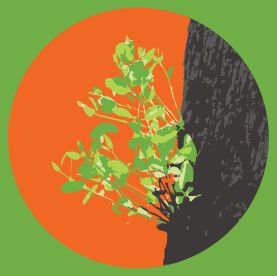
Weed management after fire webinar series (Live streamed and recorded)
Recent fire history in Eastern Victoria
The January 2020 fires in the North East and Gippsland areas of Victoria have burnt approximately 1.3 million hectares and continue an occurrence of fire in the landscape which has covered almost the entire eastern portion of Victoria over the past 20 years. Many areas have been subject to repeated fires over the past 20 years, some with short intervals between fires which is likely to have long-term impacts on the ecology of an area, changing species habitats and the ability of some species to sustain healthy populations.
Note: The following maps were compiled from Visualising Victoria's Biodiversity using a layer from The State of Victoria, Department of Environment, Land, Water & Planning FIRE_HISTORY data which represents the spatial extent of the last fires recorded, primarily on public land. The layer stores details of the last time an area was known to be burnt by wildfire or prescribed burning.
2000 to 2005
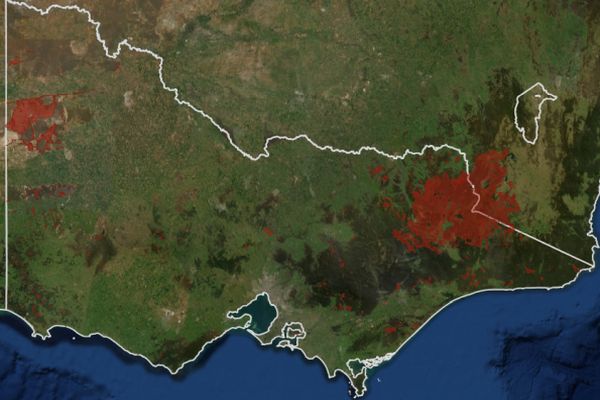
2005 to 2010
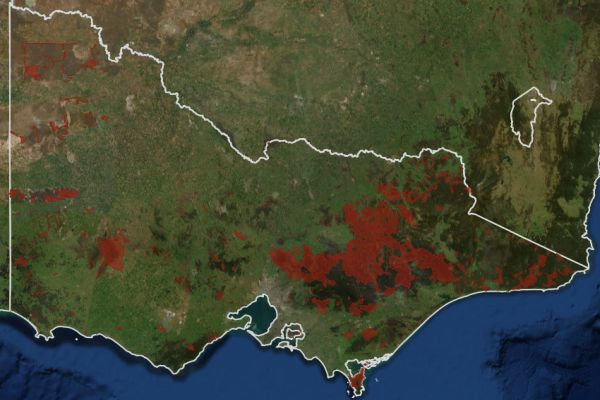
Includes Black Saturday fires 7 February 2009.
2010 to 2015
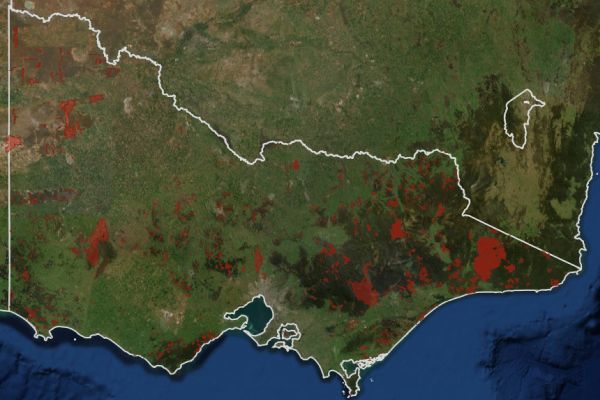
Significant fires 2013 Highland southern fall and 2014 East Gippsland uplands.
2015 to 2019
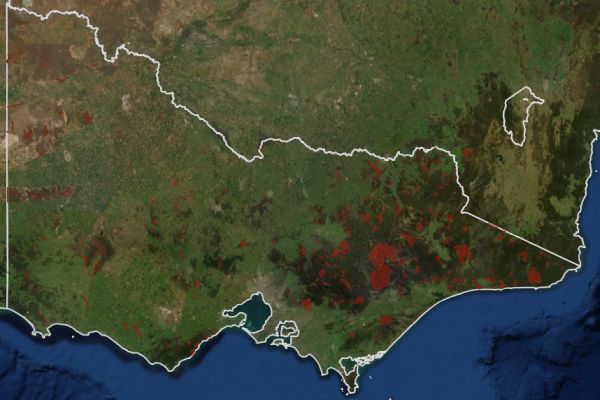
Includes 2019 fires in Victorian Alps and Highland southern fall.
1st to 9 January 2020
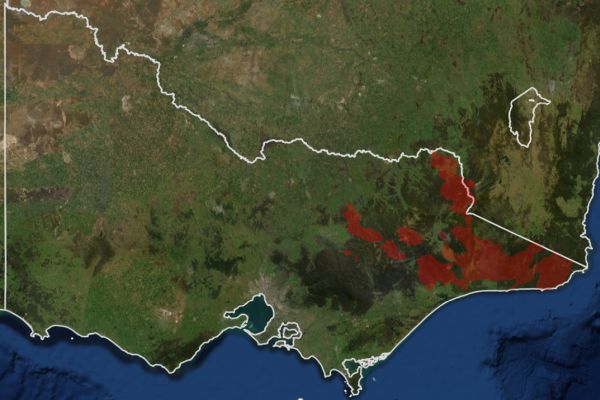
Indicative map only of 2020 fires to 9 Jan. 2020.
Threatened species in North East and Gippsland across 6 Local Government Areas impacted by fire
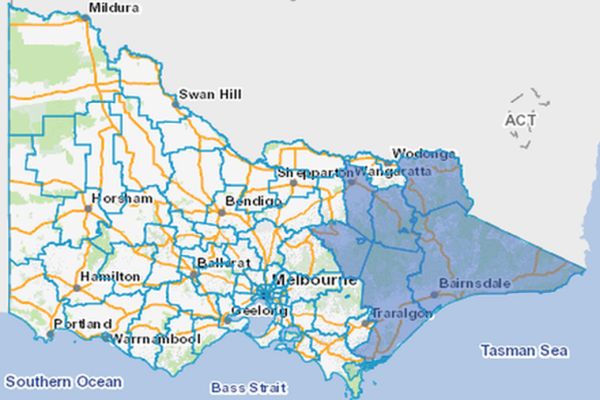
Local Government Areas declared to be in a State of Disaster by the Victorian Government (3 January 2020). Note: The shaded area represents the Local Government Areas included in the Threatened Fauna List and does not represent the areas burnt.
The following is a combined listing of threatened species in 6 Local Government Areas (Alpine Shire, East Gippsland Shire, Mansfield Shire, Towong Shire, Wangaratta Rural Shire and Wellington Shire) declared to be in a State of Disaster (3 January 2020) in the fire areas of North East and Gippsland, Victoria. The Mount Buller, Mount Hotham, Falls Creek and Mount Stirling Alpine Resorts are also included in the State of Disaster area.
This list includes all threatened species across the 6 Local Government Areas in eastern Victoria, fortunately some species will have little or no impact due to their habitat or ability to move from fire areas.
Victorian conservation status | |
| EX | Extinct |
| CR | Critically Endangered |
| EN | Endangered |
| VU | Vulnerable |
| TH | Threatened |
Common name | Scientific name | Conservation status | ||
| * Species not likely to be impacted by fires in North East & Gippsland, Victoria | Victorian FFG threatened list | |||
North East & Gippsland – threatened birds | ||||
| Australasian Bittern | Botaurus poiciloptilus | CR | ||
| Australian Bustard | Ardeotis australis | CR | ||
| Australian Little Bittern | Ixobrychus minutus dubius | EN | ||
| Australian Painted Snipe | Rostratula benghalensis australis | CR | ||
| Australasian Shoveler* | Anas rhynchotis | VU | ||
| Azure Kingfisher | Alcedo azurea | - | ||
| Baillon's Crake | Porzana pusilla palustris | - | ||
| Barking Owl | Ninox connivens | CR | ||
| Black Bittern | Ixobrychus flavicollis australis | EN | ||
| Black-browed Albatross | Diomedea melanophris melanophris | (EPBC listed) | ||
| Black-eared Cuckoo | Chrysococcyx osculans | - | ||
| Black-faced Cormorant* | Phalacrocorax fuscescens | - | ||
| Black Falcon | Falco subniger | CR | ||
| Black-tailed Godwit | Limosa limosa | CR | ||
| Blue-billed Duck* | Oxyura australis | VU | ||
| Brolga* | Grus rubicunda | EN | ||
| Brown Treecreeper | Climacteris picumnus victoriae | - | ||
| Bush Stone-curlew |
| CR | ||
| Caspian Tern* | Hydroprogne caspia | VU | ||
| Chestnut-rumped Heathwren | Calamanthus pyrrhopygius | VU | ||
| Common Diving-Petrel* | Pelecanoides urinatrix | - | ||
| Common Greenshank* | Tringa nebularia | EN | ||
| Common Sandpiper* | Actitis hypoleucos | VU | ||
| Curlew Sandpiper* | Calidris ferruginea | CR | ||
| Crested Bellbird | Oreoica gutturalis | EN | ||
| Diamond Dove | Geopelia cuneata | VU | ||
| Diamond Firetail | Stagonopleura guttata | VU | ||
| Eastern Bristlebird | Dasyornis brachypterus brachypterus | CR | ||
| Eastern Curlew* | Numenius madagascariensis | CR | ||
| Eastern Great Egret | Ardea modesta | VU | ||
| Elegant Parrot | Neophema elegans | VU | ||
| Emu | Dromaius novaehollandiae | - | ||
| Fairy Prion* | Pachyptila turtur | - | ||
| Fairy Tern* | Sternula nereis nereis | CR | ||
| Freckled Duck* | Stictonetta naevosa | EN | ||
| Glossy Black-Cockatoo | Calyptorhynchus lathami lathami | CR | ||
| Glossy Ibis* | Plegadis falcinellus | - | ||
| Great Knot* | Calidris tenuirostris | CR | ||
| Greater Sand Plover* | Charadrius leschenaultii | VU | ||
| Grey-crowned Babbler | Pomatostomus temporalis temporalis | VU | ||
| Grey Falcon | Falco hypoleucos | VU | ||
| Grey Goshawk | Accipiter novaehollandiae novaehollandiae | EN | ||
| Grey-headed Albatross* | Diomedea chrysostoma | EN | ||
| Grey Plover* | Pluvialis squatarola | VU | ||
| Grey-tailed Tattler | Tringa brevipes | CR | ||
| Ground Cuckoo-shrike | Coracina maxima | VU | ||
| Ground Parrot | Pezoporus wallicus wallicus | EN | ||
| Gull-billed Tern* | Gelochelidon nilotica macrotarsa | EN | ||
| Hardhead* | Aythya australis | VU | ||
| Hooded Plover | Thinornis rubricollis rubricollis | VU | ||
| Hooded Robin | Melanodryas cucullata | VU | ||
| King Quail | Coturnix chinensis victoriae | EN | ||
| Latham's Snipe | Gallinago hardwickii | - | ||
| Lesser Sand Plover* | Charadrius mongolus | EN | ||
| Lewin's Rail | Lewinia pectoralis pectoralis | VU | ||
| Little Button-quail | Turnix velox | - | ||
| Little Egret | Egretta garzetta nigripes | EN | ||
| Little Tern* | Sternula albifrons sinensis | CR | ||
| Magpie Goose* | Anseranas semipalmata | VU | ||
| Major Mitchell's Cockatoo | Lophocroa leadbeateri | CR | ||
| Marsh Sandpiper* | Tringa stagnatilis | EN | ||
| Masked Owl | Tyto novaehollandiae novaehollandiae | CR | ||
| Musk Duck* | Biziura lobata | VU | ||
| Nankeen Night Heron* | Nycticorax caledonicus | - | ||
| Northern Giant-Petrel* | Macronectes halli | EN | ||
| Orange-bellied Parrot | Neophema chrysogaster | CR | ||
| Pacific Golden Plover* | Pluvialis fulva | VU | ||
| Pacific Gull* | Larus pacificus pacificus | - | ||
| Painted Honeyeater | Grantiella picta | VU | ||
| Pectoral Sandpiper* | Calidris melanotos | - | ||
| Pied Cormorant* | Phalacrocorax varius | - | ||
| Plains-wanderer | Pedionomus torquatus | CR | ||
| Plumed Egret | Ardea intermedia plumifera | CR | ||
| Powerful Owl | Ninox strenua | VU | ||
| Red-backed Kingfisher | Todiramphus pyrropygia pyrropygia | - | ||
| Red-chested Button-quail | Turnix pyrrhothorax | EN | ||
| Red Knot* | Calidris canutus | EN | ||
| Regent Honeyeater | Anthochaera phrygia | CR | ||
| Regent Parrot | Polytelis anthopeplus monarchoides | VU | ||
| Royal Spoonbill* | Platalea regia | - | ||
| Ruddy Turnstone* | Arenaria interpres | EN | ||
| Sanderling* | Calidris alba | - | ||
| Shy Albatross* | Diomedea cauta | EN | ||
| Sooty Owl | Tyto tenebricosa tenebricosa | EN | ||
| Sooty Oystercatcher* | Haematopus fuliginosus | - | ||
| Southern Giant-Petrel* | Macronectes giganteus | EN | ||
| Speckled Warbler | Chthonicola sagittatus | EN | ||
| Spotted Harrier | Circus assimilis | - | ||
| Spotted Quail-thrush | Cinclosoma punctatum | - | ||
| Square-tailed Kite | Lophoictinia isura | VU | ||
| Superb Parrot | Polytelis swainsonii | EN | ||
| Swift Parrot | Lathamus discolor | CR | ||
| Terek Sandpiper* | Xenus cinereus | EN | ||
| Turquoise Parrot | Neophema pulchella | VU | ||
| Wandering Albatross* | Diomedea exulans | CR | ||
| Whimbrel* | Numenius phaeopus | EN | ||
| Whiskered Tern* | Chlidonias hybridus | - | ||
| White-bellied Sea-Eagle | Haliaeetus leucogaster | EN | ||
| White-faced Storm-Petrel* | Pelagodroma marina | EN | ||
| White-fronted Tern* | Sterna striata | - | ||
| White-throated Needletail | Hirundapus caudacutus | VU | ||
| White-winged Black Tern* | Chlidonias leucopterus | - | ||
| Wood Sandpiper* | Tringa glareola | EN | ||
North East & Gippsland– threatened mammals | ||||
| Broad-toothed Rat | Mastacomys fuscus mordicus | EN | ||
| Brush-tailed Phascogale | Phascogale tapoatafa | VU | ||
| Brush-tailed Rock-wallaby | Petrogale penicillata | CR | ||
| Burrunan Dolphin* | Tursiops australis | CR | ||
| Common Bent-wing Bat | Miniopterus orianae oceanensis (eastern ssp.) | CR | ||
| Dingo | Canis lupus dingo | VU | ||
| Eastern Horseshoe Bat | Rhinolophus megaphyllus megaphyllus | EN | ||
| Eastern Pygmy-possum | Cercartetus nanus | - | ||
| Eastern Quoll | Dasyurus viverrinus | EN | ||
| Eastern Wallaroo | Macropus robustus robustus | EN | ||
| Fat-tailed Dunnart | Sminthopsis crassicaudata | - | ||
| Grey-headed Flying-fox | Pteropus poliocephalus | VU | ||
| Leadbeater's Possum | Gymnobelideus leadbeateri | CR | ||
| Little Pygmy-possum | Cercartetus lepidus | - | ||
| Long-footed Potoroo | Potorous longipes | EN | ||
| Long-nosed Fur Seal* | Arctophoca australis forsteri | VU | ||
| Long-nosed Potoroo | Potorous tridactylus tridactylus | VU | ||
| Mountain Pygmy-possum | Burramys parvus | CR | ||
| New Holland Mouse | Pseudomys novaehollandiae | EN | ||
| Platypus | Ornithorhynchus anatinus | VU | ||
| Rufous-bellied Pademelon | Thylogale billardierii | Threatened | ||
| Smoky Mouse | Pseudomys fumeus | EN | ||
| Southern Bettong | Bettongia gaimardi gaimardi | EX | ||
| Southern Brown Bandicoot | Isoodon obesulus obesulus | EN | ||
| Southern Greater Glider | Petauroides volans subsp. volans | VU | ||
| Southern Humpback Whale* | Megaptera novaeangliae australis | CR | ||
| Southern Myotis | Myotis macropus | - | ||
| Southern Right Whale* | Eubalaena australis | EN | ||
| Spot-tailed Quoll | Dasyurus maculatus maculatus | EN | ||
| Squirrel Glider | Petaurus norfolcensis | VU | ||
| Swamp Antechinus | Antechinus minimus maritimus | VU | ||
| White-footed Dunnart | Sminthopsis leucopus | VU | ||
| White-footed Rabbit-rat | Conilurus albipes | EX | ||
| Yellow-bellied Sheathtail Bat | Saccolaimus flaviventris | VU | ||
North East & Gippsland – threatened fishes | ||||
| Australian Grayling | Prototroctes maraena | EN | ||
| Barred Galaxias | Galaxias fuscus | CR | ||
| Bluenose Cod (Trout Cod) | Maccullochella macquariensis | CR | ||
| Coxs Gudgeon | Gobiomorphus coxii | EN | ||
| Dargo Galaxias | Galaxias mungadhan | CR | ||
| Dwarf Galaxias | Galaxiella pusilla | EN | ||
| East Gippsland Galaxias | Galaxias aequipinnis | CR | ||
| Empire Gudgeon | Hypseleotris compressa | EN | ||
| Flat-headed Galaxias | Galaxias rostratus | VU | ||
| Flinders Pygmy Perch | Nannoperca sp. 1 | VU | ||
| Freshwater Catfish | Tandanus tandanus | EN | ||
| Freshwater Herring | Potamalosa richmondia | RX | ||
| Grey Nurse Shark* | Carcharias taurus | CR | ||
| Macquarie Perch | Macquaria australasica | EN | ||
| McDowalls Galaxias | Galaxias mcdowalli | CR | ||
| Murray Cod | Maccullochella peelii | EN | ||
| Murray-Darling Rainbowfish | Melanotaenia fluviatilis | VU | ||
| Golden Perch | Macquaria ambigua | - | ||
| Roundsnout Galaxias | Galaxias terenasus | CR | ||
| Shaw Galaxias | Galaxias sp. 7 | CR | ||
| Southern Pygmy Perch | Nannoperca australis (Murray-Darling lineage) | VU | ||
| Striped Gudgeon | Gobiomorphus australis | - | ||
| Tapered Galaxias | Galaxias sp. 8 | CR | ||
| Yarra Pygmy Perch | Nannoperca obscura | VU | ||
North East & Gippsland – threatened reptiles & amphibians | ||||
Reptiles | ||||
| Alpine Bog Skink | Pseudemoia cryodroma | EN | ||
| Alpine She-oak Skink | Cyclodomorphus praealtus | CR | ||
| Alpine Water Skink | Eulamprus kosciuskoi | CR | ||
| Bandy Bandy | ermicella annulata | EN | ||
| Carpet Python | Morelia spilota metcalfei | CR | ||
| Common Long-necked Turtle | Chelodina longicollis | - | ||
| Diamond Python | Morelia spilota spilota | CR | ||
| Eastern She-oak Skink | Cyclodomorphus michaeli | CR | ||
| Eastern Snakenecked Turtle | Chelodina longicollis | - | ||
| Glossy Grass Skink | Pseudemoia rawlinsoni | VU | ||
| Guthega Skink | Liopholis guthega | CR | ||
| Leathery Turtle* | Dermochelys coriacea | CR | ||
| Mountain Skink | Liopholis montana | - | ||
| Rosenberg's Goanna | Varanus rosenbergi | CR | ||
| Striped Legless Lizard | Delma impar | EN | ||
| Swamp Skink | Lissolepis coventryi | EN | ||
| Tree Goanna (Lace Monitor) | Varanus varius | EN | ||
| Tussock Skink | Pseudemoia pagenstecheri | EN | ||
| Woodland Blind Snake | Ramphotyphlops proximus | - | ||
Amphibians | ||||
| Alpine Tree Frog | Litoria verreauxii alpina | CR | ||
| Booroolong Tree Frog | Litoria booroolongensis | CR | ||
| Brown Toadlet | Pseudophryne bibronii | EN | ||
| Dendy's Toadlet | Pseudophryne dendyi | - | ||
| Giant Bullfrog | Limnodynastes interioris | CR | ||
| Giant Burrowing Frog | Heleioporus australiacus | CR | ||
| Green and Golden Bell Frog | Litoria aurea | - | ||
| Growling Grass Frog | Litoria raniformis | VU | ||
| Large Brown Tree Frog | Litoria littlejohni | CR | ||
| Martin's Toadlet | Uperoleia martini | CR | ||
| Smooth Toadlet | Uperoleia laevigata | - | ||
| Southern Barred Frog | Mixophyes balbus | CR | ||
| Southern Toadlet | Pseudophryne semimarmorata | EN | ||
| Spotted Tree Frog | Litoria spenceri | CR | ||
| Tyler's Toadlet | Uperoleia tyleri | DD | ||
North East & Gippsland – threatened invertebrates | ||||
| Alpine Stonefly | Thaumatoperl a alpina | VU | ||
| Aquatic Invertebrate | Archaeophylax canarus | DD | ||
| Brittle Star species* | Amphiura triscacantha | VU | ||
| Brittle Star species* | Ophiocomina australis | VU | ||
| Caddisfly | Archaeophylax canarus | - | ||
| Golden Sun Moth | Synemon plana | CR | ||
| Harpactacoid copepod | Canthocamptus longipes | - | ||
| Large Ant Blue | Acrodipsas brisbanensis | EN | ||
| Orange Ringlet Butterfly | Hypocysta adiante | EX | ||
| Stonefly | Riekoperla intermedia | VU | ||
Flatworms | ||||
| Planarian (flat worm) | Spathula tryssa | EN | ||
Crustacea | ||||
| Alpine Spiny Crayfish | Euastacus crassus | EN | ||
| East Gippsland Spiny Crayfish | Euastacus bidawalus | VU | ||
| Murray Spiny Crayfish | Euastacus armatus | NT | ||
| Orbost Spiny Crayfish | Euastacus diversus | EN | ||
| Riffle Shrimp | Australatya striolata | EN | ||
| South Gippsland Spiny Crayfish | Euastacus neodiversus | EN | ||
| Variable Spiny Crayfish | Euastacus yanga | VU | ||
* Species not likely to be impacted by fires in North East & Gippsland, Victoria
Note: - blank spaces indicate species previously on Advisory lists which have been reassessed as not threatened in Victoria.
Data Source: Information in this table has been derived from the Victorian Biodiversity Atlas (VBA), Department of Environment, Land, Water & Planning, Victoria, 2021. Flora and Fauna Guarantee Act Threatened List (FFG Threatened List, June 2022). Advisory List of Threatened Invertebrate Fauna in Victoria (2009), Victorian Department of Environment and Primary Industries, Advisory List of Threatened Vertebrate Fauna in Victoria (2013) and Department of Environment, Land, Water & Planning.
See also: separate lists of threatened species for each of the 6 Local Government Areas declared to be in a State of Disaster (3 January 2020).
- Alpine Shire
- East Gippsland Shire
- Mansfield Shire
- Towong Shire
- Wangaratta Rural Shire
- Wellington Shire
- The Mount Buller, Mount Hotham, Falls Creek and Mount Stirling Alpine Resorts are also included in the State of Disaster area.
Feature species
Note: Species geographic range maps are derived from the Victorian Biodiversity Atlas, 2020 and represent all known historic records and do not imply that the species is still present.
Threatened birds
Eastern Bristlebird
Dasyornis brachypterus brachypterus - Endangered, FFG Listed.
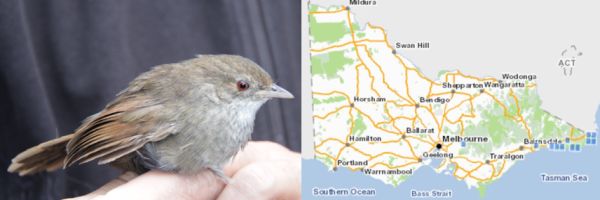
The geographic distribution of the Eastern Bristlebird in Victoria is centred in areas burnt by the East Gippsland fires. At the time of the fires only one population was known to remain in Victoria, near Mallacoota. Impacts on this species from fires in East Gippsland are likely to be exacerbated by loss of habitat along the south coast of NSW.
As of 5 February 2020, a combined effort from DELWP, Parks Victoria, Zoos Victoria, Currumbin Sanctuary, Fisheries Victoria and Monash and Wollongong universities have managed to capture 15 Eastern Bristlebirds from the only population in Victoria, near Mallacoota. The birds will be housed at Zoos Victoria until such time the fires are over and it is safe to release them back into the wild. Map: VBA 2020 (all known historic records), Image: Tony Mitchell. Eastern Bristlebird.
Ground Parrot
Pezoporus wallicus wallicus - Endangered, FFG Listed
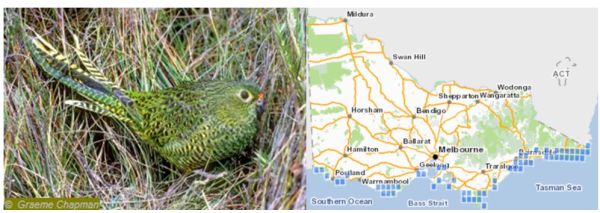
Once found in only a few locations, it is doubtful if this species occurs anywhere else in Victoria apart from East Gippsland, which has habitat severely impacted by fire. Image: Graeme Chapman. Map source; VBA 2020.
Sooty Owl
Tyto tenebricosa tenebricosa - Vulnerable, FFG Listed
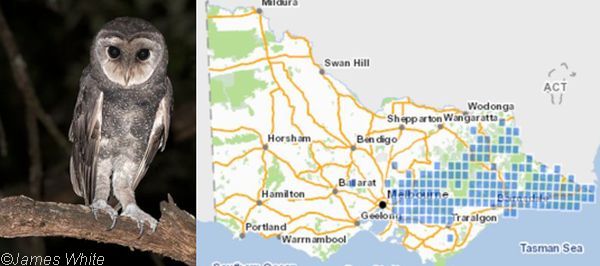
A significant part of the Sooty Owl’s known distribution in eastern Victoria has been impacted by the 2020 bushfires. Loss of nesting hollows and depletion of habitat for prey species such as gliders and possums could impact the viability of Sooty Owl populations in eastern Victoria. Surveys are required to determine the extent of habitat loss and population status. Image copyright: James White. Map: VBA 2020 (all known historic records in Victoria).
Threatened mammals
Broad-toothed Rat
Mastacomys fuscus mordicus - Endangered, FFG Listed.
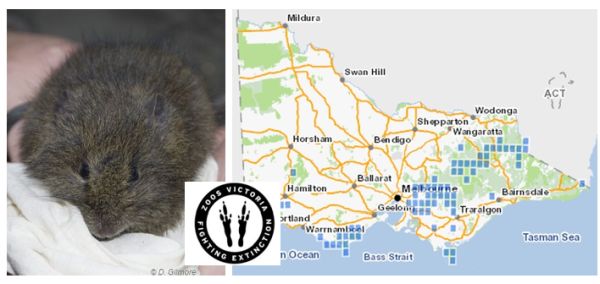
Only found in two main areas of Victoria. The populations in eastern Victoria’s high-altitude areas above 1200 m were considered a stronghold for the species but now require reassessment after the fires. On the Zoos Victoria Fighting Extinction watch list. Map source: VBA 2020. More about Broad-toothed Rat.
Brush-tailed Rock-wallaby
Petrogale penicillata - Critically endangered, FFG Listed
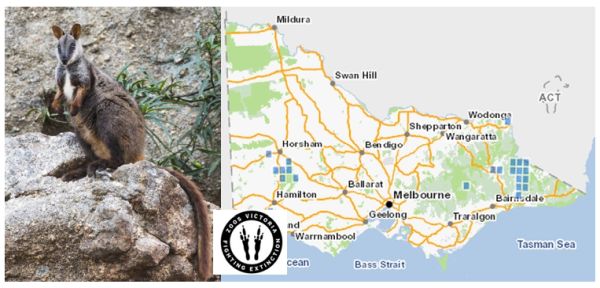
During the height of the fires it was feared this species could have been severely impacted upon. Fortunately, aerial observations carried out in early February 2020 found some of the crucial rocky gorge habitat for this species intact. Aerial feeding has been carried out to enhance survival. Further on-ground research is required to fully understand the impacts from these fires. Overall, the Brush-tailed Rock-Wallaby has suffered a major decline across its former Victorian distribution. It is struggling to survive in the wild in the Grampians and in Victoria, East Gippsland was considered its main stronghold. A Zoos Victoria Fighting Extinction species. More about Brush-tailed Rock Wallaby. Map source VBA 2020; all historic records of Brush-tailed Rock-Wallaby.
Eastern Pygmy Possum
Cercartetus nanus - Near threatened
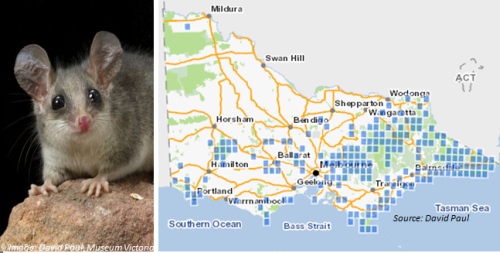
Greater Glider (Southern)
Petauroides volans - Vulnerable
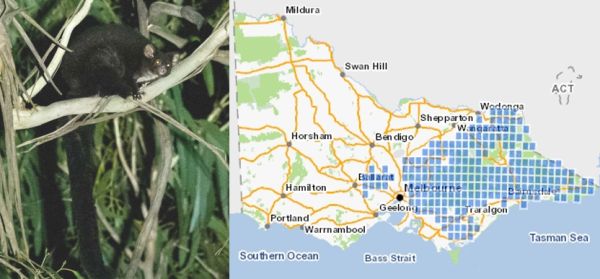
Long-footed Potoroo
Potorous longipes - Vulnerable, FFG Listed
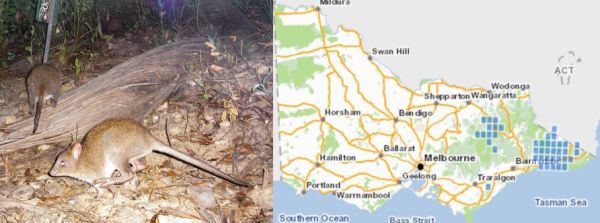
Mountain Pygmy Possum
Burramys parvus - Critically endangered, FFG Listed
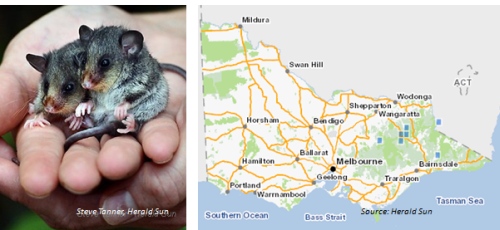
Southern Long-nosed Bandicoot
Perameles nasuta - Not on Victorian Threatened species Advisory List
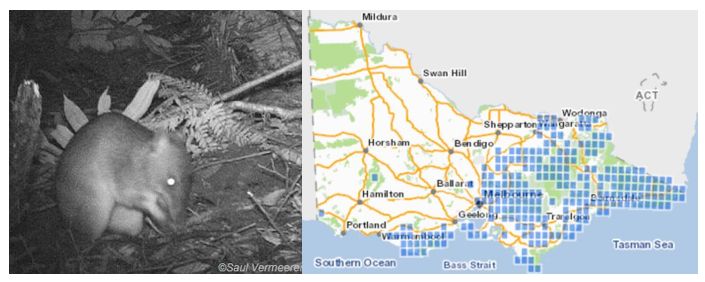
Although not on the current threatened species advisory list for Victoria this species will have suffered major decline throughout parts of its range in Victoria. Reassessment of conservation status likely. Image: Saul Veerman. Map source; VBA 2020.
Spot-tailed Quoll
Dasyurus maculatus maculatus - Endangered, FFG Listed
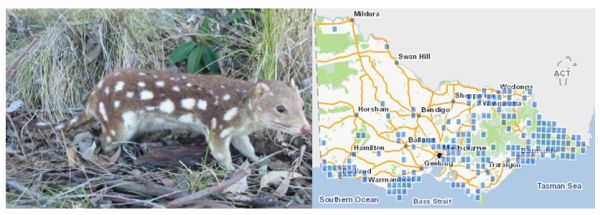
Only found in a small number of areas in Victoria. East Gippsland was considered a stronghold but will require reassessment as it is highly likely to have suffered a major decline in the eastern part of Victoria as a result of the fires. More about this secies. Image: SWIFFT. Map source; VBA 2020.
Threatened fish
A number of Critically endangered native fish have been rescued as part of the East Gippsland Water-life Rescue project. The project is designed to reduce the risk of a species becoming extinct, particularly in cases where their habitat has been impacted by ash and sedimentation entering streams from the fires. By rescuing enough individuals of each species and holding them in a secure aquarium facility it hoped reintroductions can be undertaken when stream conditions become suitable. Other species include; Yalma Galaxias (north of Orbost) and Shaw’s Galaxias. Macquarie Perch have been rescued from the Buffalo River near Abbeyard.
East Gippsland Galaxias
Galaxias aequipinnis Endangered, FFG Listed

McDowell’s Galaxias and Dargo Galaxias

McDowell’s Galaxias - Critically endangered (left); Dargo Galaxias - Critically endangered (right) . Distribution map source: VBA 2020.
The Mallacoota Burrowing Cray, and Gippsland Freshwater Mussel have also been part of the East Gippsland Water-life Rescue project.
Threatened reptiles & amphibians
Alpine She-oak Skink
Cyclodomorphus praealtus - Critically endangered, FFG Listed.
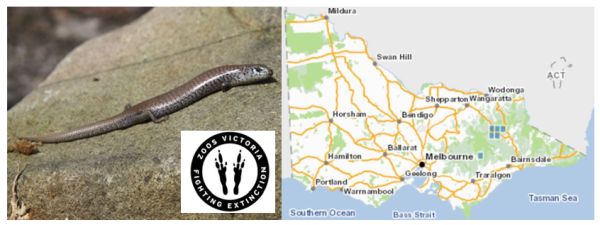
Found only in isolated alpine areas in Victoria's North East – likely to have been impacted by fire. A Zoos Victoria Fighting Extinction species. Image: Zoos Victoria. Map source: VBA 2020.
Diamond Python
Morelia spilota spilota - Endangered, FFG Listed.
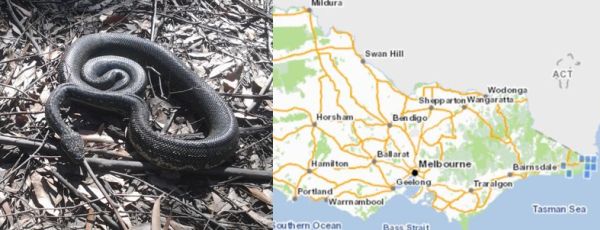
Confined to a very small area of habitat in East Gippsland, likely to be severely impacted by the January 2020 fire. Image source: ARI, Map source: VBA 2020.
Giant Burrowing Frog
Heleioporus australiacus - Critically endangered
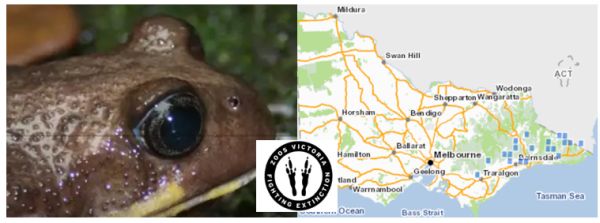
A poorly understood species which is the subject of Zoos Victoria Fighting Extinction involving research and monitoring. Map source: Image: Zoos Victoria. Map source; VBA 2020.
Wildlife response & recovery
Department of Energy, Environment and Climate Action (DEECA) response for wildlife
DEECA (formally DELWP) set up special web pages with information concerning bushfire response:
DELWP Biodiversity Bushfire Response and Recovery
Biodiversity Response and Recovery Newsletter - February 2020 pdf
Biodiversity response and recovery supplementary report: bushfire impacts on species in Victoria. pdf Department of Environment, Land, Water and Planning, Melbourne, Victoria, 2022.
Impact of the Victorian fires on biodiversity - Summary
Impact of the Victorian fires on biodiversity. - Detailed report 23/1/2020 pdf
Bushfire response: community information
Victorian Wildlife Rehabilitation Guidelines - 2023
Victorians Volunteering for Nature
Arthur Rylah Institute
ARI conducts research into the responses of flora and fauna to fire.
https://www.ari.vic.gov.au/research/fire
Zoos Victoria Recovery fund
Zoos Victoria recovery fund: https://www.zoo.org.au/fire-fund/
Threatened Species Recovery Hub
Conservation response to the 2019-20 wildfires
After the catastrophe: a blueprint for a conservation response to large-scale ecological disaster
Victorian Landcare Gateway - Fire Recovery Resources
A wide range of practical fire recovery land management information on livestock, fencing, pastures, soils, weeds, native vegetation, riparian areas and erosion, wildlife, horticulture, assistance and support services available, and fire research and reports. https://www.landcarevic.org.au/resources/fire-recovery/
Victorian Wildlife Rehabilitation Guidelines
The Victorian Wildlife Rehabilitation Guidelines were published in 2023. The guidlines contain 4 volumes (1. General information, 2. Mammals, 3. Birds, 4. Reptiles & Amphibians). The guidelines are aimed at advancing the standards of caring for sick, injured and orphaned wildlife from rescue, transport, monitoring and care through to release. The guidelines have been developed by the Department of Energy, Environment and Climate Action (DEECA) in partnership with Zoos Victoria. Published 2023.
Research and monitoring of flora & fauna in fire affected areas
SWIFFT encourages information sharing on biodiversity related activities and projects which involve species or areas burnt in eastern Victoria.
Please contact SWIFFT so we can compile a list of who is undertaking what projects on this page.
Add your project to Visualising Victoria’s Biodiversity interactive map. http://www.vvb.org.au/vvb_map.php
Select – 'Share' > 'Submit a project' and follow the prompts.
Response of native species to the 2019–20 bushfires and introduced predators in far East Gippsland
Robley, A., Cally, J.G., Murray, A., Bluff, L., Collyer, A., Borg, N. and Phillips, L. (2022). The response of native species to the 2019–20 bushfires and introduced predators in far East Gippsland. Arthur Rylah Institute for Environmental Research Technical Report Series No. 329. Department of Environment, Land, Water and Planning, Heidelberg, Victoria. View Report
This study suggests that the 2019–20 bushfires had minimal impact on the immediate (6-months) post-fire occurrence of all assessed native species, including Long-footed Potoroos, in far East Gippsland. However, there was evidence that the severity of the fire did impact site occupancy in 2020. Lace Monitors appear to be the most impacted by the fires with both Long-nosed Potoroos and Long-nosed Bandicoots also being detected at fewer sites post-fire. Long-footed Potoroos were more likely to occur at sites with low fox densities. There was no relationship between the presence of feral cats or wild dogs and the occurrence of any of the monitored species. View full rport
East Gippsland's Range Restricted Flora
Despite the importance of East Gippsland for biodiversity, surprisingly little environmental research has been undertaken in support of on-ground efforts to conserve, maintain and restore species and ecosystems in the region. Over 100 plant species in East Gippsland are listed as vulnerable or endangered at the national- or state-level, while the status of a further 90 remains uncertain. Many of these plants exist as small and/or localised populations and, for a great majority, their known distributions were severely burnt in the 2019/20 bushfires. More details.
Post fire flora surveys
A brief look at some recent plant discoveries and re-discoveries in Victoria following the 2019/20 bushfires. SWIIFT Seminar 31 October 2024, Presentation by Andre Messina - Botanist, Royal Botanic Gardens Victoria.
East Gippsland Water-life Rescue project
Rescuing threatened aquatic species after the East Gippsland bushfires. Source: DELWP.
Bushfire Recovery - community wildlife reporting
Report sightings of six key species within the 2019/2020 fire-affected (and neighbouring) areas.
Multi-species threatened butterflies in fire affected areas of East Gippsland
The Threatened Species Conservancy has undertaken over 200 surveys to establish the extent of population loss, provide a baseline for ongoing monitoring and provide advice on the recovery of the seven species of threatened butterflies. Southern Sedge-darter Telicota eurychlora - Endangered, Large Ant-blue Acrodipsas brisbanensis - Endangered, Orange-ringlet Hypocysta adiante – Extinct in Victoria, Silky Hairstreak Pseudalmenus chlorinda fisheri , Chequered Sedge-skipper Hesperilla mastersi mastersi, Two-spotted Grass-skipper Pasma tasmanica - Endangered and the Common Pencilled-blue Eirmocides absimilis.
Weed control post fire
Weed control can be a very important factor for consideration after a bushfire. There is a brief window of opportunity after fire to have a big impact on many weeds including some early invaders.
The Weeds at the Early Stage of Invasion Project has prepared a feature in the Early Invader Update; ‘Weed management and fire’ pdf. This pdf contains a synopsis of useful weed/ fire related projects and reports which could assist in undertaking weed control programs after fire events.
Early Invader Update; ‘Weed management and fire’ pdf
Weed management after fire
View the four sessions on SWIFFT YouTube, recorded from 25 Novemebr to 16 December 2020.
Weed management after fire webinars
Citizen Science
Citizen Science Bushfire Project Finder - http://www.csiro.au/bushfireprojects
Australian Citizen Science Association - Citizen Science Bushfire Response Project Audit
Further information
SWIFFT seminar notes contain further information related to this topic:
- Fire recovery and Citizen Science
- Biodiversity response and recovery - 2020 bushfires in Eastern Victoria
- Indigenous knowledge of ecology
- Learning from the Indigenous Fire Workshop, Cape York
- Threatened species population supplementation
- Zoos Victoria Fighting Extinction recovery projects

View video - https://data.giss.nasa.gov/gistemp/animations/5year_6y.mp4
On average across Australia, we are experiencing about 1-degree Celsius increase in mean annual temperature since the industrial revolution, in line with global temperature increases, and more extreme events.
